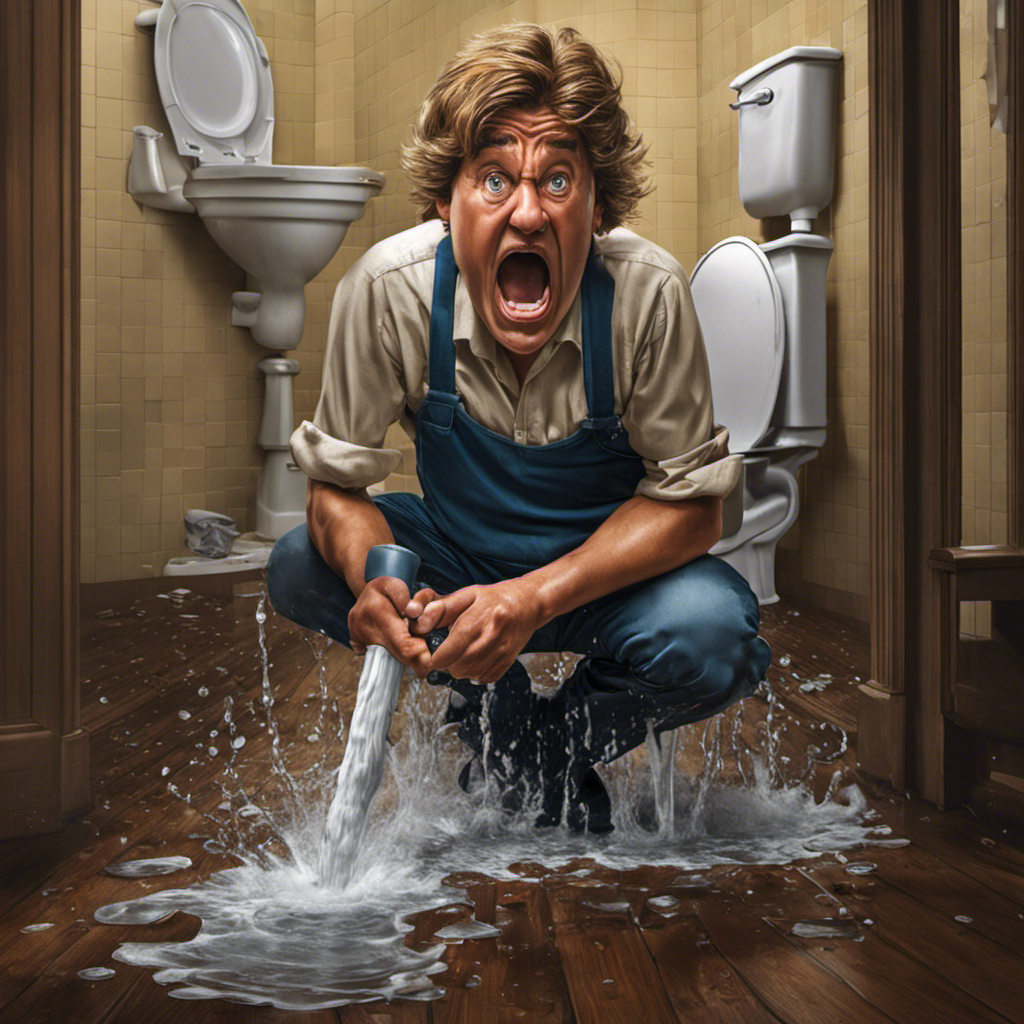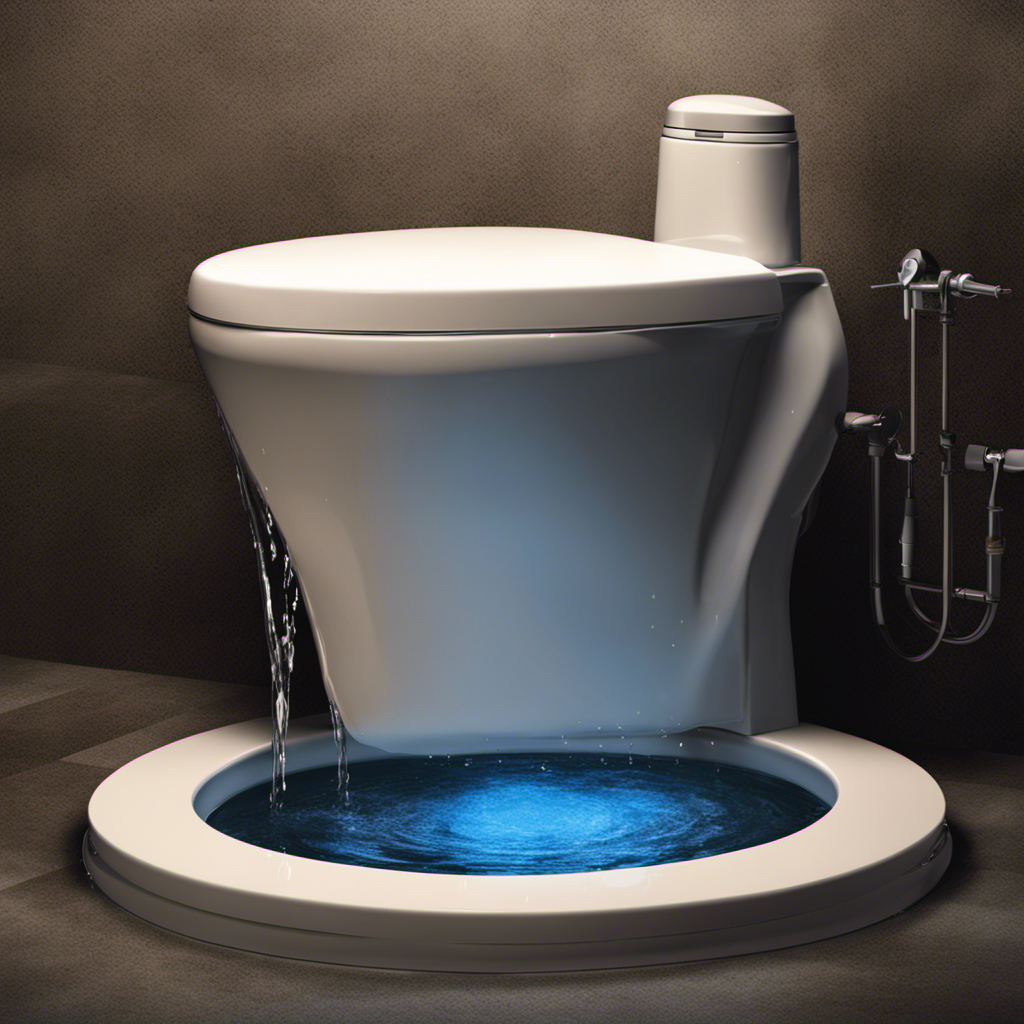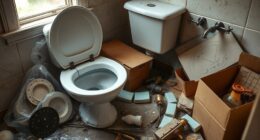Did you know that a running toilet can waste up to 200 gallons of water per day? That’s a staggering amount, both for the environment and your water bill.
But fear not, because I’m here to show you a simple solution that will stop that running toilet in seconds. In this article, I’ll guide you through the step-by-step process of assessing the issue, identifying common causes, and providing the tools and supplies needed for a quick repair.
Say goodbye to wasted water and hello to a more efficient bathroom!
Key Takeaways
- The flapper valve is a common cause of a running toilet.
- A faulty flapper valve can cause a continuously flushing toilet.
- A toilet clog can also result in a continuous flush.
- Promptly addressing these issues prevents overflow and water damage.
Assessing the Issue
First, you’ll want to check if the flapper valve is the cause of the running toilet. This is a common issue that can lead to water wastage and higher bills.
If your toilet keeps running even after you flush, it’s likely that the flapper valve is not sealing properly. One symptom of this is a constant sound of water flowing.
To fix this, turn off the water supply to the toilet and remove the tank lid. Inspect the flapper valve for any signs of damage or wear. If it looks worn out or doesn’t seal tightly, it’s time to replace it.
Flapper valves are inexpensive and can be found at most hardware stores. Simply remove the old one and attach the new one according to the manufacturer’s instructions.
This should solve the running toilet issue and restore proper functionality.
Identifying Common Causes
One common cause of a continuously flushing toilet is a faulty flapper valve. The flapper valve is a rubber seal located at the bottom of the toilet tank. Its purpose is to hold water in the tank and release it into the bowl when the toilet is flushed. If the flapper valve becomes worn or damaged, it may not seal properly, causing water to continuously flow from the tank into the bowl. This can lead to a running toilet and potential water wastage.
Additionally, a toilet clog can also cause a continuous flush, as the water tries to push through the blockage. It is important to address these issues promptly to prevent overflow and water damage.
Now, let’s discuss the tools and supplies needed to fix a running toilet.
Tools and Supplies Needed
To fix a continuously flushing toilet, you’ll need a few tools and supplies. Here’s what you’ll need:
- Toilet repair kit
- Adjustable wrench
- Screwdriver
- Replacement toilet flapper
A toilet repair kit is essential for fixing a running toilet. It typically includes a flapper, fill valve, and other necessary components. The adjustable wrench will help you loosen and tighten bolts and nuts. A screwdriver is needed for removing the tank lid and accessing the inner mechanisms. Finally, the replacement toilet flapper is crucial for stopping the continuous flushing.
With these tools and supplies on hand, you’ll be ready to tackle the step-by-step repair process.
Transitioning into the subsequent section, let’s now explore how to use these tools to fix a running toilet in seconds.
Step-by-Step Repair Process
Now that you have all the necessary tools and supplies, you can easily fix your continuously flushing toilet in just a few simple steps.
First, turn off the water supply by locating the shut-off valve near the base of the toilet.
Next, remove the toilet tank lid and check for any visible leaks or cracks. If there are none, it’s time to clean the tank.
Empty the tank by flushing, then use a scrub brush and mild detergent to clean the inside walls. Rinse thoroughly and remove any debris.
Once the tank is clean, check the flapper valve for any signs of wear or damage. Replace if necessary.
Lastly, turn the water supply back on and test the toilet for any leaks or continuous flushing.
Now you’re ready to move on to troubleshooting tips to address any other issues that may arise.
Troubleshooting Tips
When it comes to troubleshooting a malfunctioning toilet, there are three key points to consider: water level adjustment, flapper replacement, and valve inspection.
Adjusting the water level is crucial in ensuring proper flushing and preventing overflow.
If the flapper is worn or damaged, it may cause water leakage, requiring a replacement.
Lastly, inspecting the valve is essential to identify any blockages or leaks that could be affecting the toilet’s functionality.
Water Level Adjustment
The first thing you’ll want to check is if the water level in the toilet tank is set too high. If it is, the excess water can lead to a running toilet. Here are some steps to adjust the water level and prevent overflow:
- Locate the water level adjustment screw or float arm inside the toilet tank.
- Turn the screw counterclockwise to lower the water level or adjust the float arm downwards.
- Flush the toilet and observe if the water fills up to the desired level.
- If necessary, make further adjustments until the water level is just below the overflow tube.
By adjusting the water level, you can ensure proper water pressure and prevent any potential overflow issues.
This simple fix can save water and prevent unnecessary running toilets.
Flapper Replacement
To replace the flapper, you’ll need to turn off the water supply to the toilet. This is a crucial step in toilet repair and should not be skipped.
Once the water supply is off, you can remove the lid of the toilet tank and locate the flapper. The flapper is a rubber piece that seals the flush valve. Over time, it can become worn or damaged, causing the toilet to run continuously.
To replace the flapper, simply disconnect it from the chain and attach the new one. Make sure it is properly aligned with the flush valve.
Once the new flapper is in place, turn on the water supply and test the toilet for any leaks.
Now, let’s move on to the next step – valve inspection.
Valve Inspection
After turning off the water supply, I inspect the valve for any signs of damage or leaks. This step is crucial in stopping a running toilet and ensuring the proper functioning of the toilet system.
Here are some things to check for during the valve inspection:
- Check for any cracks or breaks in the valve body.
- Look for signs of corrosion or rust on the valve.
- Examine the valve seal for any wear or tear.
- Inspect the valve connections for any loose fittings or leaking pipes.
Preventive Maintenance Measures
When it comes to preventive maintenance for a toilet, there are three key points to focus on:
-
Regular water flow: Regularly monitoring the water flow ensures that there are no obstructions or issues that can lead to a running toilet.
-
Checking the flapper valve: Checking the flapper valve ensures that it is properly sealing and not causing any leaks.
-
Adjusting the water level: Adjusting the water level helps to prevent overflow and wasted water.
Regular Water Flow
A running toilet can waste a lot of water if the regular flow is disrupted. To stop the running water, there are two main methods you can try: shutting off the water supply and using a plunger. Here’s how to do it:
-
Shutting off water supply: Locate the water supply valve behind the toilet and turn it clockwise until it is fully closed. This will stop the water from flowing into the tank and prevent further waste.
-
Using a plunger: Place the plunger over the drain hole at the bottom of the toilet bowl. Press down firmly and then pull up quickly, creating suction. Repeat this motion several times until the water starts to drain properly.
Check Flapper Valve
To check the flapper valve, first remove the tank lid and observe the rubber flapper at the bottom of the tank.
The flapper valve is an essential component of a toilet’s flushing system. It controls the release of water from the tank into the bowl when you flush.
Over time, the flapper valve may deteriorate or become misaligned, resulting in water leaks and a running toilet. Regular flapper valve maintenance is necessary to prevent this.
Inspect the rubber flapper for any signs of wear or damage. If you notice any issues, such as cracks or warping, it’s time for flapper valve repair.
Replace the old flapper with a new one and ensure it is properly aligned to create a watertight seal. This simple maintenance task can save water and prevent costly repairs down the line.
Adjust Water Level
You can adjust the water level in your toilet by turning the float adjustment screw clockwise or counterclockwise. This simple adjustment can help prevent water wastage and promote water conservation.
Here are some preventive measures and tips to conserve water in your toilet:
- Check for leaks regularly by adding food coloring to the tank and observing if it seeps into the bowl.
- Install a dual-flush mechanism to allow for different water volumes depending on the need.
- Consider using a displacement device, like a toilet tank bag or bottle, to reduce the amount of water used per flush.
- Insulate the toilet tank to prevent condensation and potential leakage.
Frequently Asked Questions
Can I Use Regular Household Tools to Fix a Running Toilet, or Do I Need Specialized Plumbing Tools?
I can use regular household tools to fix a running toilet. I don’t need specialized plumbing tools. It’s important to have a plunger, adjustable wrench, and possibly a screwdriver to address common toilet issues.
Are There Any Temporary Fixes I Can Try While Waiting to Purchase the Necessary Supplies to Fix My Running Toilet?
While waiting to purchase supplies for my running toilet, there are temporary fixes you can try. Look into alternative solutions like adjusting the float or replacing the flapper valve to stop the running.
How Long Does It Usually Take to Repair a Running Toilet?
To repair a running toilet, troubleshooting the issue and identifying common causes is crucial. Once the problem is pinpointed, the necessary repairs can be completed. To prevent future running toilets, regular maintenance and timely fixes are essential.
Will Repairing a Running Toilet Require Me to Turn off the Water Supply to My Entire House?
No need to panic! There are alternative ways to stop a running toilet without turning off the water supply to your entire house. Let me show you how to identify the common causes without professional help.
Can a Running Toilet Cause Any Damage to My Plumbing System if Left Unfixed for an Extended Period?
If left unfixed for an extended period, a running toilet can cause potential consequences and long-term effects on your plumbing system. It is important to address the issue promptly to avoid further damage.
Conclusion
In conclusion, fixing a running toilet can be a quick and simple task that anyone can tackle. By following the step-by-step repair process and using the right tools, you can stop the constant flow of water in just seconds.
Remember, prevention is key, so don’t forget to regularly maintain your toilet to avoid future issues. Just like a well-oiled machine, a properly functioning toilet can keep your bathroom running smoothly.
So don’t let your toilet be a leaky faucet, take action and fix it today!










